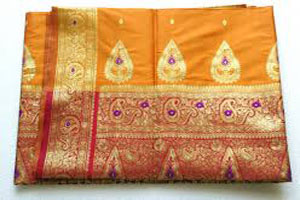
Indian fashion designers make attempt to give Benares silk a new life
YarnsandFibers News Bureau 2015-07-06 17:00:00 – VaranasiBenares silk sari, an age old rich, painstakingly hand woven traditional fabric of India, once the prized possession of every Indian woman and an essential item in a bride’s trousseau is quickly losing out in the popularity strakes to trendy, - factory made Chinese weaves. To save it from turning into a museum relic, top twenty four designers from India recently met in the city of Benares, Uttar Pradesh, along with top officials from India’s textiles ministry, to brainstorm on how to reinvent the fabric.
Apart from providing weavers with design ideas, the designers have promised to base their next collections on the textile. The new collaboration will lead to a new product line that will be showcased in India before it is promoted abroad.
Over the past couple of decades, Benares silk has become starchy, stiff and overdecorated – in other words, uncomfortable to wear. The real decline began after the weavers, hoping to appeal to new customers, moved away from the beautiful motifs and patterns that the fabric is famous for, and began adding cheap ¬embellishments.
Consumers began buying silk saris imported from China, which are cheaper than traditional weaves and come in a variety of new designs and colours.
They replaced the yarn that used to produce a soft, flowing fabric, and ended up with something stiff, said fashion ¬designer, Ritu Kumar. They have stopped using real gold thread because it was too expensive, but opted instead for a bright-yellow substitute which looked awful and made the sari even stiffer.
Mumbai-based designer¬-turned-politician Shaina Nana Chudasama made an attempts to bring together some of the country’s best talent to provide the weavers with some much-needed ¬design direction in her latest project.
Tarun Tahiliani, Neeta Lulla, J J Valaya, Anamika Khanna, Wendell Rodricks and Rohit Bal are among the designers expected to offer ideas based on market ¬demands, helping weavers ¬revamp Benares silk so that it remains relevant to contemporary women. This also means producing a sari that is light, drapes well, and can be worn every day.
New Delhi socialite, Simi ¬Duggal admits she loves her Benares silks, but finds wearing them too difficult as they’re so heavy and can’t move easily in them. So prefer crepes and chiffons which are easier to manage.
The 1.2 million weavers in this cottage industry, for whom this is the only source of income, are desperate for help. Skills that date back to Mughal times have been passed from one generation of artisans to the next. But times are changing. Demand has fallen so badly that many have left the city to work as taxi drivers and office clerks in other parts of India.
Kumar pioneered efforts a few years ago to save the precious silk fabric – and the impoverished weavers – as part of larger efforts to preserve India’s dying crafts.
At the heart of it, the campaign looks to protect handloom weavers against machine-made and power loom competitors that duplicate their designs. Kumar helps the craftsmen to create new designs and colour palettes with the intent that these new looks will entice customers to once again purchase the saris.
At the 50 looms she runs in Benares, weavers are provided with yarn that yields soft fabric. With no existing samples of old saris to offer as a reference to the current generation of weavers, Kumar lends from her family collection of rare weaves to inspire them to return to the artistic -glory that had once made the handwoven silk so famous.
But some believe it is absurd to treat handwoven saris as “sacrosanct†pieces of Indian culture. Sari designer Sanjay Garg, owner of the local Raw Mango handwoven textile brand, said it’s important to be realistic.
Some handwoven fabrics are hard to maintain, they go funny in the washing machine, they can’t be put out in the sun, the colours bleed. So let’s not idolize them. They are lovely but so are other fabrics, he said.
But Chudasama disagrees that it is not just a matter of sentiment or national pride but equall important for the survival of Benares’ weaving community who have skills that cannot afford to lose. These skills need to be backed up, not just by design inputs, but by infrastructure, giving them yarn at subsidised rates, setting up dyeing centres and improving buyer-seller networks so that they can earn a living.
Market Intelligence
Ask for free sample Report

experience
Customer Base
dedicated team
Countries Served Worldwide









